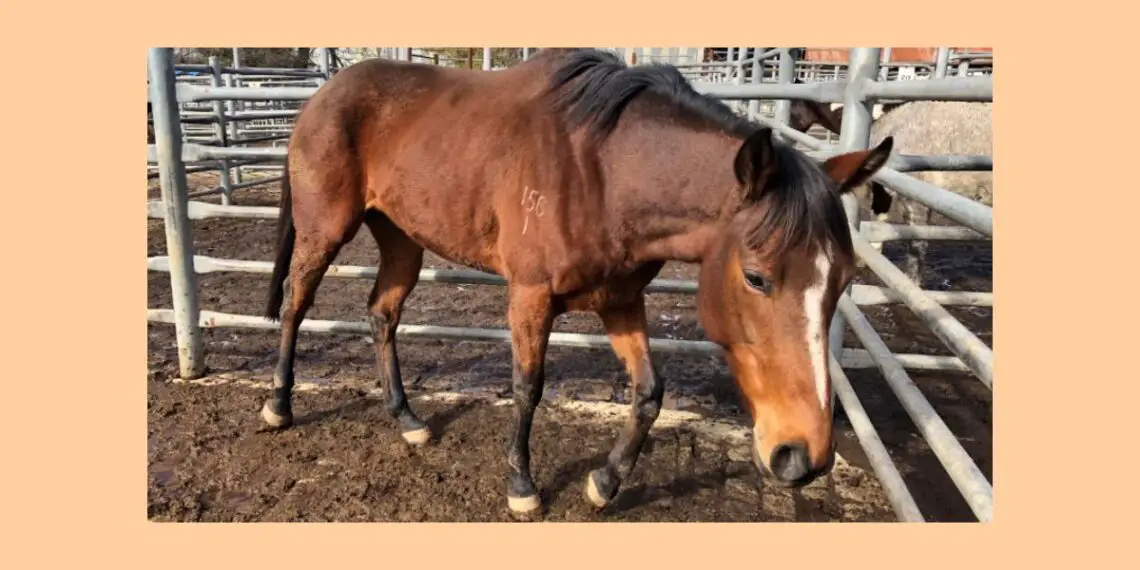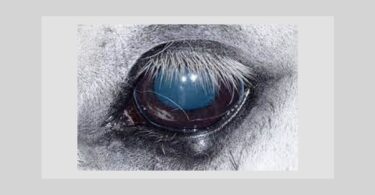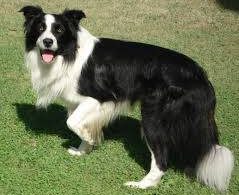Does Jeff, the ex-racehorse think that he has been (ab)used?
Jeff’s story is not unusual. He was bred to become a racehorse and spent a few years of his early life in racing yards.
Although horse racing is said to be the sport of Kings, the life of many of the horses used for this sport is less than desirable. Locked up in a box for 22 hrs per day, fed a ration too high in energy and too low in fibre, endurance of repetitive micro strain injury as a consequence of the efforts that are demanded from them, often ridden with ill fitted saddles: these are some of the daily realities for the many who are chosen and prepared to win a race.
Many racehorses are being rescued by people who make an effort to offer the ones that are evicted from the racing circuit at ages of between 5 and 12, an active but peaceful retirement. These people spend lots of time and energy on rehabilitating these ‘retired’ horses.
Jeff is one of them. His owner acquired him at the age of twelve.
When I first see him he is twenty. I am not sure whether he has ever been completely well.
His owner enjoyed taking him on rides but there were signs of occasional lameness. Things became really bad when four years prior to the consultation, my client was hospitalised and Jeff appeared to have harmed himself on purpose during her absence.
I was called out due to persistent low grade lameness. Jeff also often refused to leave his field to go out riding. A colleague had diagnosed a pedal osteitis. This is a chronic inflammation of the bone in the hoof. The cause of the disease is officially unknown but it is most likely to do with the use of horseshoes. Jeff like all other racehorses has been shod all his life.
He also has a large scar on the fetlock (1st inter-metatarsal joint) of the left hind leg. Jeff suffered a serious injury before he was rescued. Skin grafts were used to mend the lesion. He was considered a valuable horse in his younger days because of his good breeding.
August 2006, the owner tells me the following:
‘He is much better in open space. He was less happy in a previous field that was more enclosed.
He self harms. He injures himself and doesn’t care. He is insensitive to pain. He was very good when I needed to change the dressings when he hurt himself.
He once broke the left eye arcade. He banged his head against a wall; just wobbled for a second and then went on eating as if nothing had happened.
He is OK in a box. He will never have his head out of the door. He stands in the back: he has no interest in what is going on outside. You can leave the door of the stable open and he doesn’t come out.
In a previous yard he would happily go out with the other male horses but he would be on his own in the field. He was upset once when one particular mare left the yard.
He doesn’t like his personal space being invaded: he puts his ears back but he doesn’t kick.
When a stranger comes into his field he wrinkles his face.
He never looks for shade, whether it is raining or when the sun is out. When it was warm, I found him standing against his shelter on the south side … in the sun.
He pulls a face when I put covers on him but he doesn’t push them off.
When we do go out on hacks, he doesn’t spook, he does what I ask but he naps (he wants to go home). Often he does not want to go out of his field.
He only likes galloping, he does nothing else but walk or gallop (He is a race horse but still this indicates he brings not much variety into his life). He does no dressage, trotting or jumping. He loves galloping that is all. If he can be bothered he will occasionally canter in the field.
He trots like a camel because he can’t be bothered to trot normally. He used to stand in the middle of the field and watch the other horses play and race around.
He tenses when you tack up. He doesn’t really want to go out. But he has impeccable manners and does not put a foot wrong. He is polite. He has never been naughty.
He tends to shut off, he doesn’t give a lot, he doesn’t care. As long as he is on his own he is OK. He doesn’t like leaving his field. He is not really tense on hacks but he is not really relaxed.
When I was in hospital for a while he got worse because I didn’t see him for two months. He decided to hurt his leg. He is more shut off since then. This was after I had him for four years.
He eats a lot. When I give him oats it makes no difference. (Usually horses and especially thoroughbreds will have more pent-up energy from eating oats.)
He won’t come to me when I call him in the field: he knows I will go to him.
He has worked a lot in his time. Now he has no ambition, he doesn’t want to work. One day I asked him whether he wanted to live. That is how depressed he looked.
The pedal osteitis started when he was in a field doing nothing. (One would expect such lesions to aggravate after a serious work load.)
Even when he is poorly he still eats. (Rather usual for horses.)
He was castrated late. He used to mount the mares but when was asked to tease he refused.’
Solution:
Four things were striking.
– It is not unusual for horses to nap (not want to go out riding), but standing in the box without going out with the door open or not putting their heads out of the box is rather unusual: I used the symptom ‘Homesickness’ to illustrate this phenomenon. I understand the symptom as the patient hating change.
– Another unusual streak was the indifference to others. Horse are usually very social animals who do not wish to be on their own: ‘Alone ameliorates’
– I used ‘Lack of physical irritability’ due to his apparent indifference to injury. This symptom can also illustrate his general indifference.
– ‘Mildness’ is justified because one would expect a thoroughbred to be more expressive in his response to things not liked. Although many racehorses are so institutionalized that they do behave very well, one usually senses a streak of energy or feistiness in their reactions. There was none in this case.
Sum of symptoms – Sum of symptoms – Intensity is considered
|
1 |
1234 |
1 |
MIND – HOMESICKNESS |
73 |
|
2 |
1234 |
1 |
MIND – COMPANY – aversion to – alone amel.; when |
44 |
|
3 |
1234 |
1 |
MIND – MILDNESS |
93 |
|
4 |
1234 |
2 |
GENERALS – IRRITABILITY, physical – lack of |
80 |
|
carb-an. |
hell. |
ph-ac. |
phos. |
plb. |
sep. |
ambr. |
bar-c. |
caps. |
caust. | |
|
5 |
5 |
5 |
5 |
5 |
5 |
4 |
4 |
4 |
4 | |
| 1 | ||||||||||
|
3 |
2 |
3 |
2 |
1 |
1 |
– |
1 |
4 |
2 | |
| 2 | ||||||||||
|
1 |
1 |
1 |
1 |
2 |
4 |
1 |
2 |
– |
– | |
| 3 | ||||||||||
|
1 |
1 |
1 |
2 |
1 |
2 |
1 |
– |
1 |
1 | |
| 4 | ||||||||||
|
2 |
3 |
3 |
1 |
1 |
2 |
2 |
1 |
3 |
1 |
Carbo animalis: he who has the impression he sacrificed himself for the others and is left with nothing. The remedy suited the case. Jeff appears to be burned out, there is not much reaction. He doesn’t want to go out anymore, even when his symptoms do not appear to indicate that he is in a terrible state.
Does he have the feeling that he has been ‘used’ for the racing sport and when his owner ‘disappeared’ for a while when she was in hospital did this aggravate this delusion?
On 6 August 2006 he receives a 30c dose once per day for three days.
This is followed by a general improvement. He is more willing to hack out and becomes a little more communicative with his owner.
October 2006, he receives one dose of Carbo animalis 200 because the improvement lapses and, following the dose, he picks up again.
Then the owner decides to remove his shoes and move on to barefoot management. This is always a big step for a horse, but thanks to his remedy, Jeff will overcome the occasional hurdles of abscesses and other changes in his feet with an occasional dose of Carbo animalis.
I used the 30c dilution for three days twice in spring 2007. The details of this prescription can be found on the page:
https://hpathy.com/veterinary-homeopathy/a-remedy-for-an-abscess-or-a-remedy-for-the-patient/
In September 07 lots of changes occur in his hooves and he needs further support.
A dose in 200 helps but is not sufficient.
Two weeks later he receives a dose in 1M and has done very well since.
A few words on the remedy:
Carbo-an sacrificed himself for the others. The remedy is prepared from beef that is burned: all substance has disappeared during the preparation of this remedy.
Carbo-an is there for the others but is afraid to lose his substance when he gets burned.
Disappointed he is not recognised for what he did for the others. Cannot rest and cannot recuperate.
Others have burned him. He can only communicate through the flesh. He does not want to open himself through sensation and lose his capacity for sensitiveness in communication.
(References for this remedy picture: Guy Loutan and Marc Brunson)
——————————
Ben (the second horse in the previous article) and his feet and his metabolism.
The first time I saw Ben was in June 05.
I was asked to treat his sarcoids. (Sarcoids are unpleasant warty growths on the skin of horses that have a tendency to spread and/or become large, ulcerating and painful.)
I was told he was a headstrong nine year old Welsh Cob who easily took a leading position in the field. He settled well when he was moved several times from one yard to another.
These are some of the things the owner told me:
‘He has some anxiety behaviour around being ridden. He is spooky. It is better when he is with other horses. He has always been silly to ride: he rears and jumps around. The osteopath said there is no connection between his front and back.
He will jump when spooked but settles very quickly.
He doesn’t like it when you give him an order: he feels unfairly treated.
He is a bit of a bully and will pick on the weaker ones. He doesn’t mind walking through puddles or having his body hosed down but he will not accept his feet being hosed.
During riding he is concerned about doing the right thing, he is unsure about it all. This is because the person on the ground is not there: when you lead him he is fine. As soon as you are on him he has less confidence (i.e. when you are not leading him).
As a foal he was locked in a stable and was destined to become a stallion. It never happened.
He was slow to develop physically and grew until he was seven.’
On the idea of needing somebody to guide him and the slow development I prescribed Baryta carb 200c, one dose.
With the remedy he gained in confidence (all the people who knew him noticed it). The sarcoids stopped growing but did not disappear.
I am called out again in October 2006.
Ten days previously he had been sedated for dental work. The dose of the sedative may have been too high and he had fallen over. He had needed a few stitches.
He also, more than before, suffered with the typical obesity problems from which many of his type of horse suffer, and the common complication of laminitis (inflammation in the feet). There was some evidence of structural changes in his feet due to the chronic laminitis.
The Baryta carb had helped with his confidence level but had not prevented a slow aggravation of his obesity problems and the typical metabolic problems and laminitis associated with this.
Ben had been kept barefoot for the last few years and I am not convinced that the trimming was as good as it should have been.
He had been slight foot-sore all summer but got worse the last few days before I saw him. He had been moved to a yard with a harder surface (concrete) to walk on.
I gave him a few doses of Arnica followed by a new dose of Baryta carb.
A few days later he is slightly better but the improvement is not convincing.
I stop for a longer interview:
‘He has been mounting the girls this year. He got much fatter this summer. He prefers the group rather than one horse. He doesn’t like to be alone. Even a fence is a separation from the other horses. He broke an electric fence and we found him grazing on the other side of it.
He is dominant over Jack, my other horse, and doesn’t like it when the other horses disappear even when Jack is there. He does like Jack because he always calls for him even if he goes out with the other horses.
When he is with the other horses in the field he is not really interested in them and just grazes on his own.
When Ben is upset he takes it out on Jack, especially when Jack gets some attention from me.’
Ben ran a temperature during this episode of laminitis and his owner noticed he urinated less. He was also sweating a little.
I check the rubric: Kidney, urine suppressed with fever and decide, based on his aversion to being locked in a particular area of the field, to give him Plumbum met. 30C, two doses per day for three days.
After the three days he is much better and we follow on with a single dose of Plumbum 200.
I see him for an update three weeks later. The improvement is still there but more needs doing to control his unbalanced metabolism.
He still shows grumpy behaviour towards Jack, he is still very hungry.
I go through the whole file again and in the repertory, I also notice the rubric: Kidneys, urine suppression, with sweating (which was present when he was unwell). Lycopodium is present in this rubric.
The remedy fits well with a little tyrant who is (was) not all that confident.
He receives two doses in 30c.
He does well on the remedy. He loses weight and the laminitis disappears until July this year.
When I saw Ben again in July 2007, he had suffered a new acute phase of laminitis with the suspicion of an abscess brewing in his right fore. Initially, over the phone, we suspected a trauma due to having walked over the hard road and used Arnica and Hepar sulphur to no avail.
When I saw him four days later, the foot with the abscess was warm and he took the typical laminitis posture, leaning backwards on his feet. This indicated how bad things really were. Hoof testing showed there was a painful spot (abscess) in the tip of his right fore hoof.
I learned that he had been very good over the winter. The Lycopodium had not only cured the previous laminitis attack but also made him more relaxed. He used to be a bully but was now much more tolerant of his friends. Also, the grass in the spring had not caused him to put on so much weight. His condition was much more appropriate. Only in the last two weeks had he started to put on weight.
More details about this prescription can be found on the page:
https://hpathy.com/veterinary-homeopathy/a-remedy-for-an-abscess-or-a-remedy-for-the-patient/
I therefore prescribed Lycopodium 7c twice per day until response.
Ben improved so much after the first dose that he did not need any further remedy. The abscess healed without even breaking out.
Three months later, Ben is still very well and grazing in the field without much need to restrict his grass intake. In chronic laminitis cases one would suspect that any excess of grass would prevent a crisis from subsiding or would cause a new crisis to appear.






